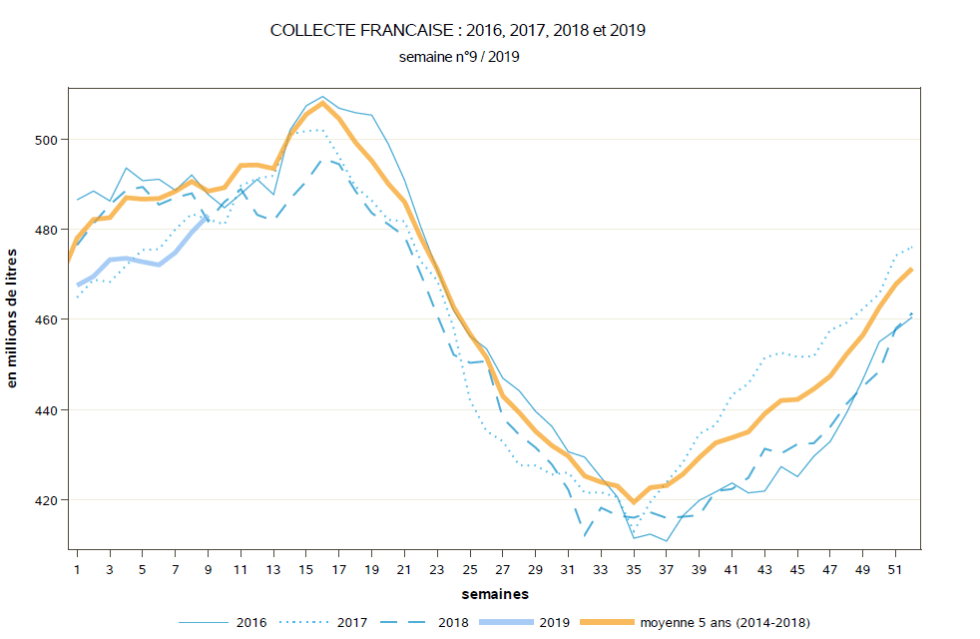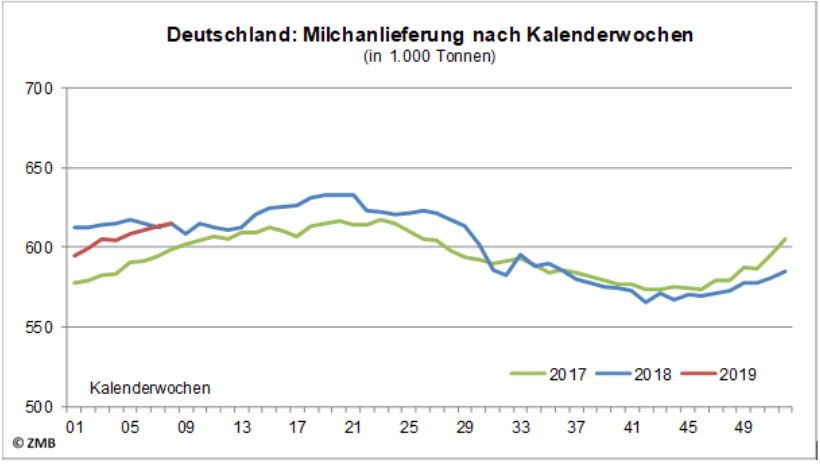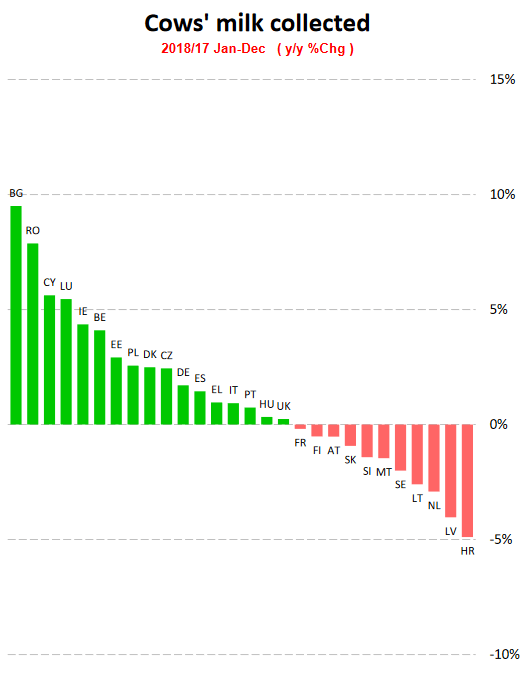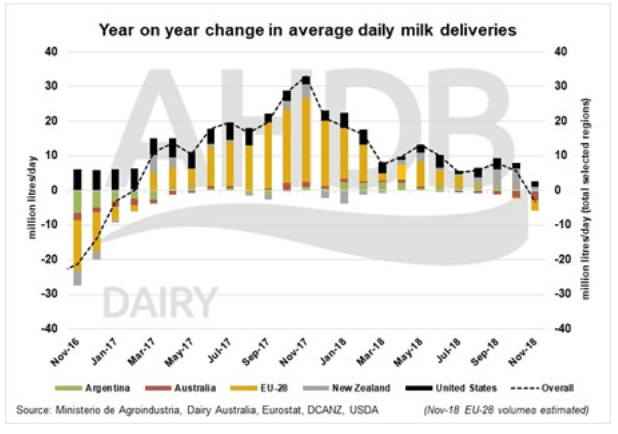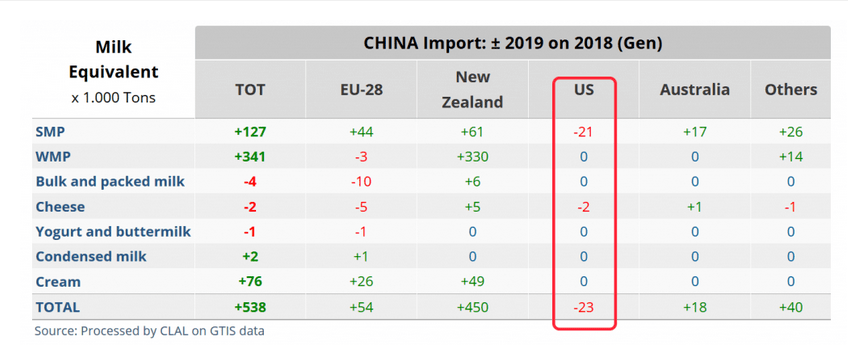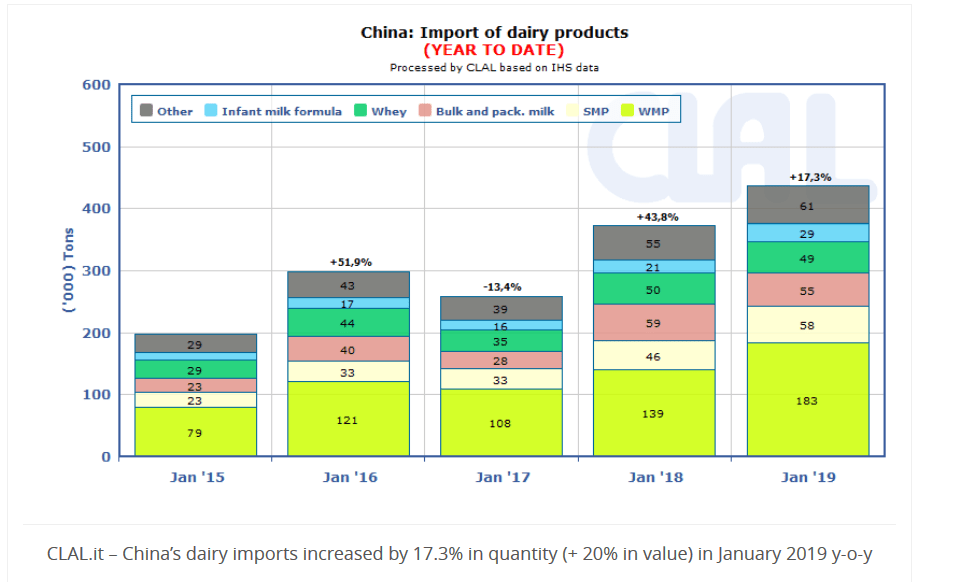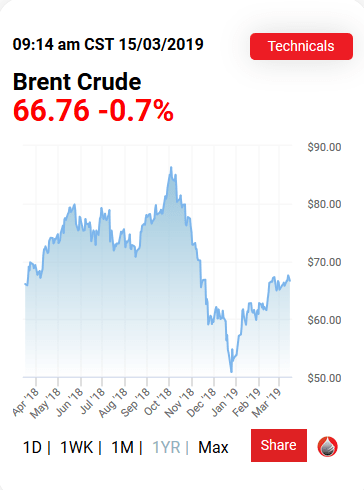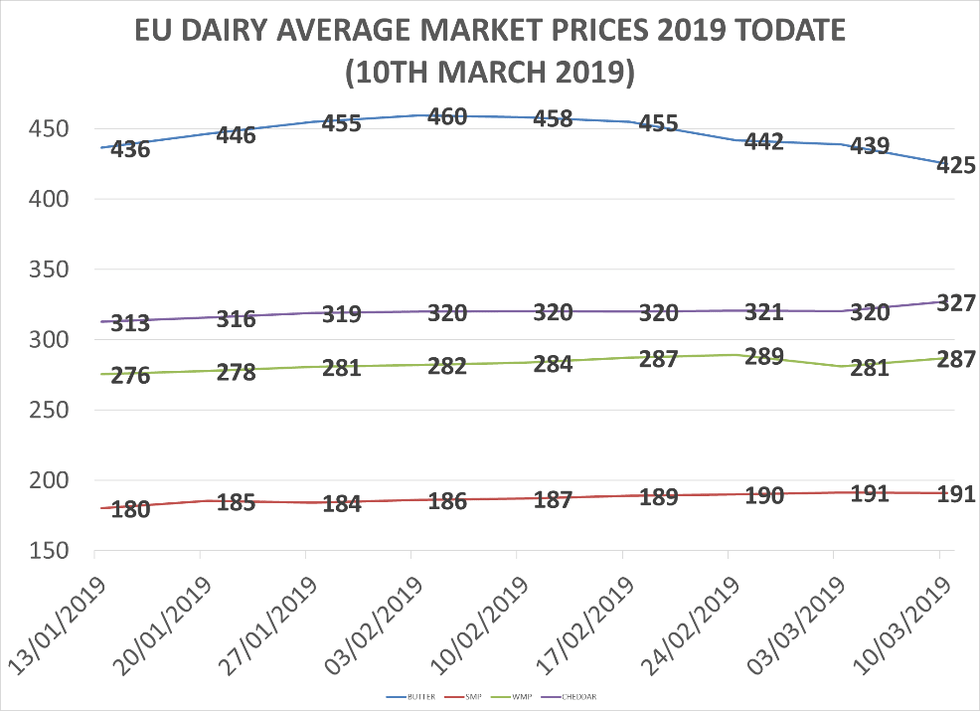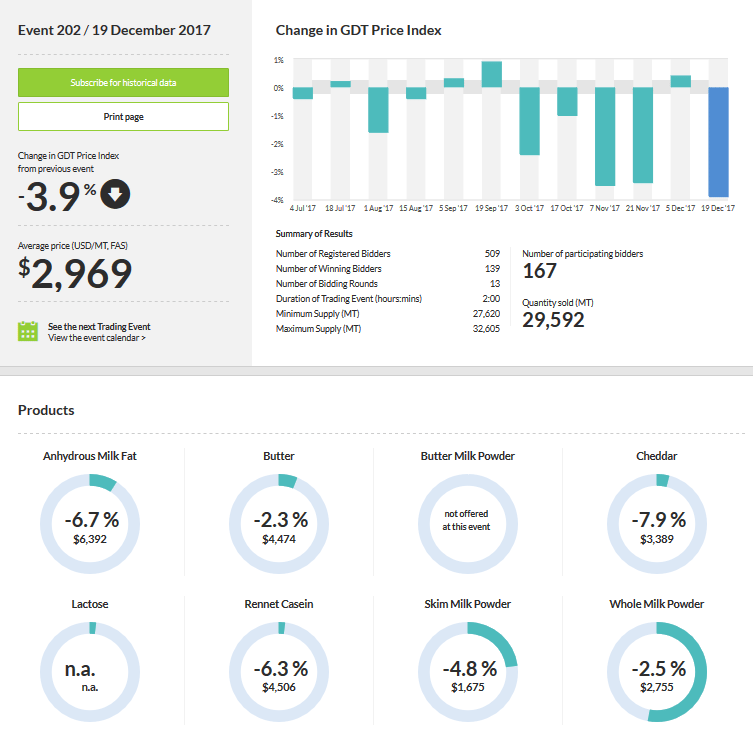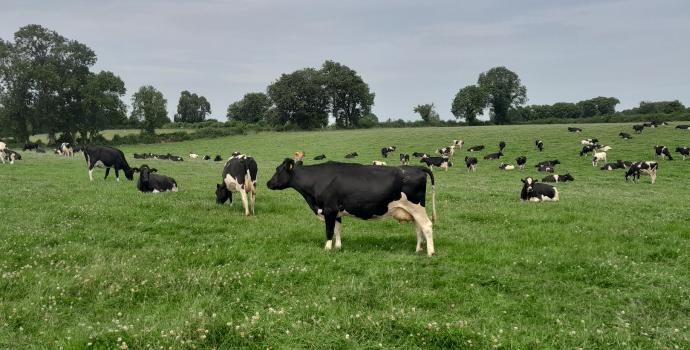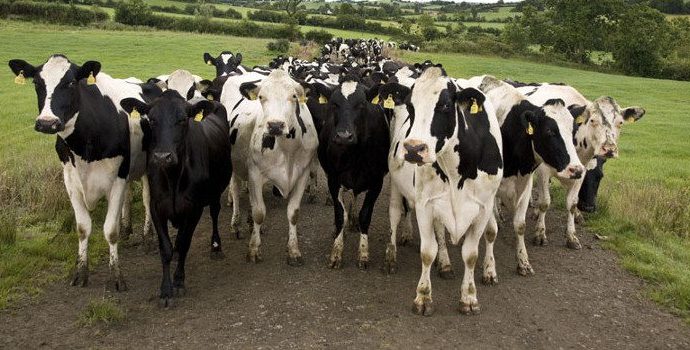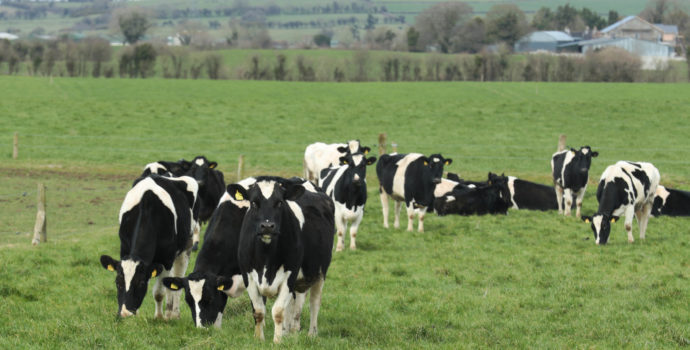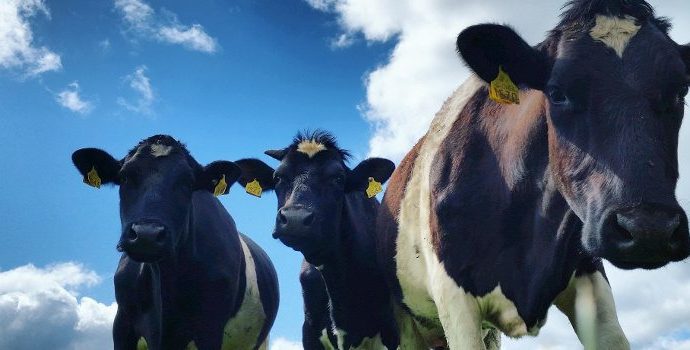
2019 a year of relative dairy price stability – but with the uncertainty of Brexit
EU volumes edging up
While the USDEC graph on the right indicates continued slower global milk output growth as far as January, more recent production trends are showing the early stages of a pick-up.
This, combined with the uncertainty of the Brexit situation (see more on Brexit below), is influencing markets towards greater caution.
EU milk deliveries for 2018 were up 0.9% only, and December was actually 1% down on December 2017. The vagaries of weather during the year put pressure on most of the main milk producing countries, with fodder shortages and rising feed costs moderating supplies.
Dutch milk deliveries continue to be impacted by the herd restrictions related to phosphates implemented since last year. January output was back over 5%, while production for the calendar year was down 2.9%.
French milk deliveries to the 9th week of the year (last week of February) were up 0.3% compared to the same week last year. This is the first time that production exceeds the same week in the prior year since last August. However, it leaves national output still well below the 5-year average, as has been the trend for practically all of 2018 (see graph right).
The French milk output for the full calendar year 2018 were 0.2% down on 2017.
German output had also been depressed relative to 2017 since August 2018, but because it had been more expansive in the first half of the year, the annual output figure for 2018 was 1.7% higher than 2017. After the more recent dip, production has now come to match last year’s in the third week of February.
Together, the Netherlands, France and Germany account for over 46% of all of the EU’s milk output – the trends in those strong dairy countries therefore determines the trend for the whole of the EU.
Global supplies also picking up
Estimates suggest that global collections have started to recover, albeit relatively modestly. Global output is believed to be up 0.4% for January.
Within this, the US January output is estimated to be up 0.5% – a very much more modest rate than increases earlier in 2018.
New Zealand January supplies were up a massive 7.7% – albeit in comparison with a much weaker January 2018. The June to December 2018 period, which includes both the trough and peak of the NZ season, was up 4.4%.
The short-term outlook in New Zealand is for continued output growth, weather permitting. However, regulatory restrictions related to climate change and the environment will likely limit longer term expansion.
Australian production in 2018 has been beggared by a succession of drought and floods. For January 2019, it is down a whopping 11% compared to the same month last year. For the full year todate, this is down 5.8%.
Demand strong in N Asia and China, stable to weak elsewhere
Demand continues to grow strongly in North Asia. Cream, cheese and liquid milk imports were weaker, but but were offset by strong butter and powder volumes with WMP particularly strong. After a sluggish Q2/Q3 period, Q4 imports were exceptionally strong. Jan imports have continued to grow steadily.
Chinese imports spefically have soared in January, and reflect two main things: first, the trade war with the US, and second the fact that the use of the NZ tariff free import quotas for WMP tend to be front loaded to the earliest part of the year.
Source: CLAL
In South East Asia, 2018 saw higher levels of imports, driven by strong SMP demand (no doubt boosted by low prices), WMP and whey. On the other hand, imports of butter and cheese fell.
In the Middle East and North Africa (MENA), 2018 saw a limited recovery in import levels after a depressed 2017 – again, price levels being the influential factor. The first quarter of 2018 was the strongest, and imports eased thereafter. Butter imports were down, with SMP and cheese up slightly, and WMP also on the up.
In the Western world, EU domestic demand has been quiet, cheese and butter growth sluggish. Domestic SMP consumption has been weaker, but exports have increased strongly. Domestic WMP consumption has also increased.
In the US and North America generally, cheese consumption has held up well in 2018. Butter demand had eased, but has recovered towards year end. Domestic consumption and exports of SMP are weak.
Oil prices and affordability of dairy product prices
The export earnings of oil producing countries have been affected by relatively low oil prices in recent months. Since the end of 2018, prices have dropped from around US$ 80 to around US$60-65, dropping even to US$50 in January.
Lower oil revenues affect the ability of some emerging countries to afford food imports, including dairy products, and so there is always a positive correlation between high oil prices and strong demand for dairy products, leading to higher dairy products. The opposite is happening at the moment.
That said, lower dairy prices for much of 2018, and easier butter prices since the history busting highs of 2017, have made products more affordable.
Source: oilprice.com
EU dairy prices in a lull
Since the beginning of 2019, we have seen a renewed pick up in butter prices which had been easing through much of 2018. In the last couple of months, however just as SMP prices were picking up in earnest, butter prices have lost ground.
EU average SMP prices seem to have plateaued around €1910/t, while spots have not been able to lift above €2000.
WMP prices have continued to firm steadily since the beginning of the year to reach an average of €2870/t. Cheddar cheese has also been inching up to €3270/t, benefiting from Brexit-related stock piling.
Whey powder prices have been hovering since early January between €890/t and €850/t (currently €860/t), with both average prices and spots easing in most recent times.
Based on EU MMO data
Source: INTL FCStone
Dairy returns – most indicators stable to easier
The table below tracks the returns from the main indicators available, from EU MMO average and raw milk spot prices, to the EU average dairy product spot prices, to the Ornua PPI and the GDT auction of 5th March (next one is on next Tuesday 19thMarch).
Most European based indicators would return a stable to easier milk price equivalent, while the GDT, which was on its 7thconsecutive uptick on 5th March, was well up, but from low levels.
That said, the improved GDT prices since early December have led Fonterra to revise upwards their forecast milk price for the 2018/19 season to between NZ$6.30 and 6.60 (26.28 to 27.54c/l), with a dividend of 15 to 25 cents in addition – a total payout of up to 28.58c/l. Not great, but a major improvement on earlier forecast.
Sources: EU MMO, INTL FCStone, Ornua, GDT
Source: GDT
Brexit – new tariffs would damage Irish exports competitiveness in case of No Deal
Not a lot to say about Brexit, other than the British Parliament has this week successively voted against the Withdrawal Agreement agreed last December between the UK and the EU (including Backstop), against a “No-Deal” Brexit, and last night in favour of looking for a postponement of the 29th March exit date.
Voting against the “No Deal” is well and good, but in the absence of a deal – and the Parliament has voted against the only deal on the table – the potential remains for the UK to crash out on 29th March or later if a delay is granted. The likely length of the delay is unclear – UK wants short, EU wants longer, but both have implications which are well documented in media reports, so I won’t go into it.
Importantly, the British Government have published a set of import tariffs they would be implementing in the event of a “No Deal” Brexit. For a number of products – not just food products – the tariffs are set at zero. For many products, including food products, they are set at WTO levels. However, for a number of food sectors, the tariffs are set at a variety of levels, mostly less than WTO tariffs.
Should a “No Deal” Brexit arise, the tariffs would apply to all imports of those products into the UK, regardless of provenance – putting Irish and, say, US or NZ imports into the UK in the same situation, but making Irish exports to the UK significantly less competitive.
Dairy specific tariffs are proposed by the UK government for two dairy products only for which all imports from anywhere would face those tariffs:
- Cheddar €221/t (normal WTO tariff is €1671/t) – the new UK tariff for Cheddar is equivalent to 2.26c/l
- Butter €605/t (normal WTO tariff is €1896/t) – UK tariff for butter alone is equivalent to 2.6c/l – note this does not allow for SMP tariff, which would be WTO level, and would add substantially to this.
The uncertainty around Brexit, the yo-yo effect on Sterling and the stockpiling which has boosted demand in recent months but could depress it even in the case of a Brexit postponement or deal, all have created greater caution on milk prices by all milk purchasers around Europe, including Ireland.

